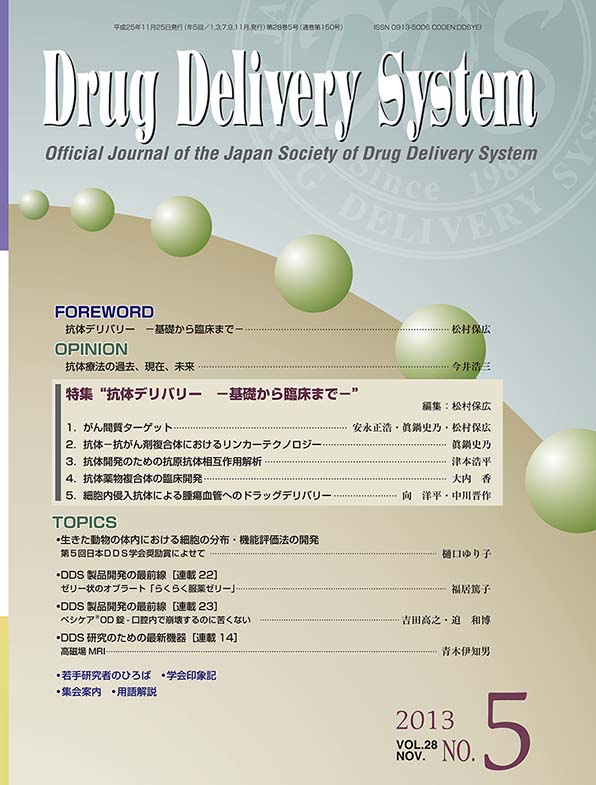All issues

Volume 28 (2013)
- Issue 5 Pages 396-
- Issue 4 Pages 270-
- Issue 3 Pages 180-
- Issue 2 Pages 92-
- Issue 1 Pages 10-
Volume 28, Issue 5
Antibody Delivery - From bench to bedside -
Displaying 1-5 of 5 articles from this issue
- |<
- <
- 1
- >
- >|
Feature articles "Antibody Delivery From bench to bedside" Editor: Yasuhiro Matsumura
-
Masahiro Yasunaga, Shino Manabe, Yasuhiro Matsumura2013Volume 28Issue 5 Pages 396-405
Published: November 25, 2013
Released on J-STAGE: March 01, 2014
JOURNAL FREE ACCESSAntibody-drug conjugate (ADC) targeting tumor cells themselves was effective for hematological malignancy or breast cancer having hyper- vascularity and poor stroma. However, it was not effective for the refractory tumors such as brain tumor, scirrhous gastric cancer or pancreatic cancer. Dense stroma prevents the ADC form reaching the tumor cells within the tumor tissues. To overcome "stromal barrier", we created "CAST (Cancer stromal targeting) therapy" using ADC targeting to a tumor stroma. We have succeeded in developing anti-cancer agent (SN-38) conjugated anti-collagen 4 antibody or anti-fibrin antibody. The therapy damaged both tumor cells and tumor vasculature. Bone marrow toxicity, hepatorenal disorder or autonomatous harmful immune response was not recognized. Further evaluation of the CAST therapy is necessary for a future clinical application.View full abstractDownload PDF (1442K) -
Shino Manabe2013Volume 28Issue 5 Pages 406-411
Published: November 25, 2013
Released on J-STAGE: March 01, 2014
JOURNAL FREE ACCESSLinker technology is important for antibody-drug conjugate development. Linker connects antibody and anti-cancer agent. The linkage between antibody-drug conjugate must be stable during blood circulation, yet the anti-cancer agent should be released at cancer lesion. In this manuscript, the aspect of various linkers and spacers will be described.View full abstractDownload PDF (440K) -
Kouhei Tsumoto2013Volume 28Issue 5 Pages 412-423
Published: November 25, 2013
Released on J-STAGE: March 01, 2014
JOURNAL FREE ACCESSAntibodies have been widely used for therapeutics and diagnosis due to their high specificity and affinity for the targets; development of antibodies has been extensively investigated in various fields. Once we obtain the genes encoding a monoclonal antibody, we can engineer various molecules using the antibody genes as a recognition element. However, it is not so far since we could understand how an antibody creates the specificity and affinity for the target from structural and energetic viewpoints. In this review, we firstly summarize three methods for biophysical characterization of antibody-antigen interactions. Second, we review our recent progresses on understanding how an antibody recognizes the target antigen from structural and energetic viewpoints. Finally, we discuss how we can create and improve the affinity of an antibody toward the target.View full abstractDownload PDF (1349K) -
Kaori Fujimoto-Ouchi2013Volume 28Issue 5 Pages 424-429
Published: November 25, 2013
Released on J-STAGE: March 01, 2014
JOURNAL FREE ACCESSAn antibody-drug conjugate (ADC) is a new way of formulating antibody drugs that achieves specific binding to the antigen and can deliver the drug to the disease site. The recent advances in antibody specificity, linker technology, and drug optimization have made it possible for ADCs to enter clinical trials. In the present review, I would like to make a summary of ADCs that have been launched or are currently being developed.View full abstractDownload PDF (449K) -
Yohei Mukai , Shinsaku Nakagawa2013Volume 28Issue 5 Pages 430-438
Published: November 25, 2013
Released on J-STAGE: March 01, 2014
JOURNAL FREE ACCESSMonoclonal antibodies (mAbs) that are internalized into cells are a current focus in the development of DDS-based drugs such as antibody-drug conjugates (ADCs). The discovery of potent cell-internalizing mAbs, however, requires labor-intensive screening of a massive number of candidates. Here we describe a phage display-based high-throughput screening system to rapidly isolate cell-internalizing mAbs, then also discuss about the efficacy of tumor vascular targeting with cell-internalizing mAbs which target tumor endothelial cells.View full abstractDownload PDF (1787K)
- |<
- <
- 1
- >
- >|